
|
||
|
Portland art blog + news + exhibition reviews + galleries + contemporary northwest art
|
||
Contemporary Modern at Lewis and Clark 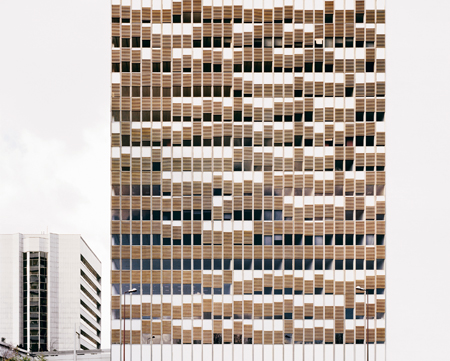 Rémy Lidereau, Puteaux, France, April 2004 reGeneration, a sprawling group exhibition, opens with an ambitious promise: These "photographs of tomorrow" will be known in twenty years. Curators William A. Ewing, Nathalie Herschdorfer, and Jean-Christophe Blaser from the Musée de l'Eysée solicited submissions from the world's top photography schools, selecting work by fifty photographers whose portfolios showed the skill, creativity, and ambition not only to endure, but to become major representatives of their generation. 
The range of work included in the show is as broad as its premise. Forced together by a theme that can be summed up simply as "good," reGeneration has a tendency toward the chaotic, with many awkward groupings and subtler images disappearing into the shadows of their neighbors. However, upon individual inspection, almost every photograph demonstrates both a formal and conceptual strength that would seem to fulfill the curatorial promise. We'll have to check back in twenty years to know much about their longevity, but this exhibition is certainly showcasing some of the most talented and well educated photographers of today. 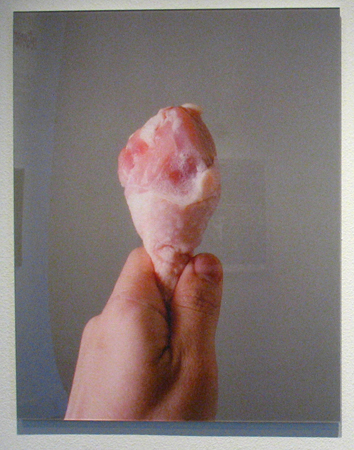 Chih-Chien Wang, "Drumstick" As modern business is said to be in the process of globalization, so too is the art of reGeneration. From East-to-West émigrés to an Israeli artist untangling AmerIsrael, many of the photographers are anxious to explore the way personal and national identity is transformed as cultural boundaries become blurrier. I use the term anxious because we are not yet truly global (can an individual ever be?), and there is an inevitable resistance and anxiety stemming from the fear that as we absorb something new, we may lose an integral part of ourselves. Chih-Chien Wang's work interrogates this conflict. Born in Taiwan, Wang immigrated to Canada as an adult. Much of his photography is preoccupied with his role as artist and emissary, communicating across the iconic divide of East and West. In Drumstick (above), part of his Object series, Wang triumphantly presents the innocent, yet slightly grotesque rawness of a chicken leg. Expressed in an even color palette of peaches and pinks, there is a persistent sameness to the photograph. Everything, he reminds us, tastes like chicken. 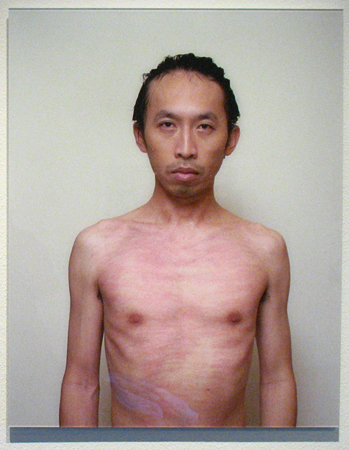 Chih-Chien Wang, "Red Man" Cultural communication suddenly becomes more difficult when we turn our attention to Red Man, part of his Self Portrait series. Wang confronts the camera with a flat affect that borders on the menacing, his eyes fixed on an indeterminate point above the viewer, refusing to offer any information with his gaze. His body is covered with light red lacerations, reminiscent of the marks of a whip, and his head and hair are dripping as though he has just emerged from the shower. Red body, Red Man, he plays both on the associations with Chinese communism and the racist meaning of the phrase, suggesting an illusory otherness in a white-dominated, but no longer white-majority, Western world. His body is wet - is he trying to wash away his difference, this redness? Or is he hearkening back to his native island of Taiwan, reminding us of its cultural independence from the "red" People's Republic of China? The pairing of Drumstick and Red Man challenges the viewer to reexamine cultural assimilation, not only between the East and West, but in the conflict between mainland China and Taiwan. 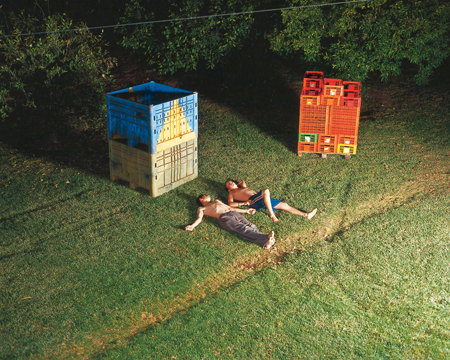 Keren Assaf, Untitled, Israel In her Israel series, Keren Assaf, an Israeli artist, photographs idyllic scenes of modern Israeli life and compares them to equally tranquil moments in suburban America. The elegantly composed photographs offer visual evidence of the sprawl of American influence. Assaf wants to demonstrate the spread of American ideals to Israel and the Middle East - not the grandstanding of democracy or the flash of wealthy capitalism, but the quiet consumerism of the middle class. In her photographs, the Israeli people are living the suburban American dream. Assaf, who staged the Israeli images with her own family, suggests an underlying tension to the apparently peaceful moments. Their cultural identity - her identity - stands in danger of being eclipsed by the ease of Americana. The images also recall the ongoing conflict that both the U.S. and Israel experience with the rest of the Middle East. Opening up cultural communication is essential to improving political communication, but we would be wise to consider just what is being shared. How is America represented by the aspects of our culture that have begun to encroach upon Israel and the surrounding region? 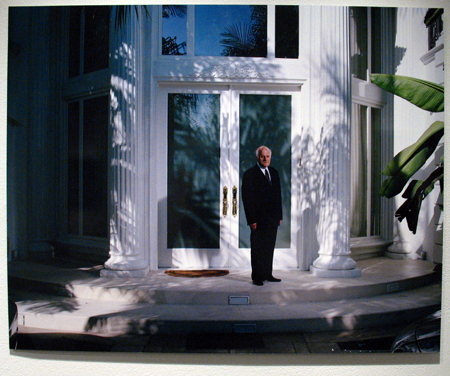 Anoush Abrar, "Samuel" The work of Iranian-born Swiss artist Anoush Abrar further examines the ethnic and racial tensions of the Middle East. Abrar presents us with Samuel, from the Iranian Jewish Community in Los Angeles series. Samuel stands in a dark suit, scowling at the camera, in front of the entrance to what appears to be a large, opulent home. He and his community are displaced from their ethnic roots, but not living as refugees - they inhabit the wealthy Jewish community of Los Angeles. Jewish and Iranian, Samuel's ethnicity is a pointed reminder of the violent ongoing ethnic conflicts in the Middle East. But also wealthy and American, Samuel represents the sprawling global network created by business and power. In this figure we see the strangely 21st century parallels created by diaspora and world trade. 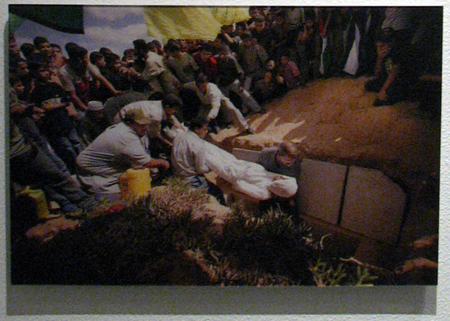 Christoph Bangert, "The funeral of a Hamas fighter" It is impossible to talk about the Middle East without talking about war, and reGeneration does not shy away from the subject. A trio of images from German artist Christopher Bangert explore Palestinian life: A cluster of hooded Hamas soldiers, a mother clutching her sleeping child, a community watching as the body of a Hamas fighter is lowered into the ground. Beside this series is French-born Swiss artist Matthias Bruggman's uncomfortably beautiful large-format photograph of British soldiers searching a terrified Iraqi child and her family. 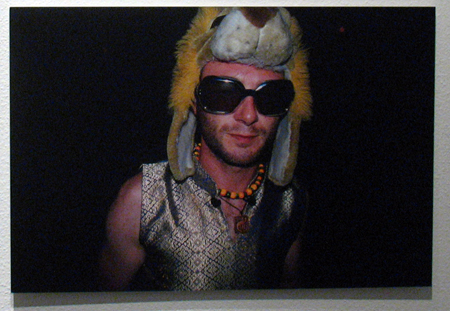 Charlotte Player, "Mike" Down the wall is British artist Charlotte Player's series of portraits of young men in Sarajevo. Player photographs them smoking, dancing, addressing the camera in stylish sunglasses. She offers an image of war-torn culture that is not defined by war, but exists in the actions and affectations of its youth. 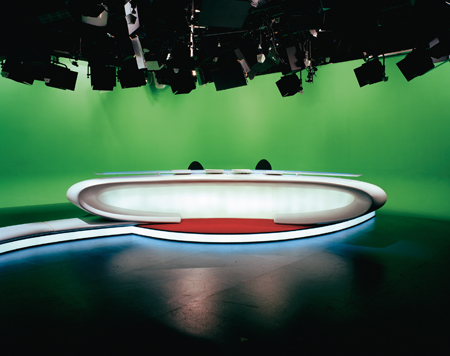 Shigeru Takato, "Cologne V" Between Player's Sarajevo portraits and Bruggman's scene from Iraq are a trio of images from Japanese photographer Shigeru Takato's Television Studios series. Takato depicts images of television studios, fully lit, vibrant, colorful, gleaming - but completely empty of human presence. Takato's series presents the dehumanizing artificiality of television culture, in brilliant color. Placing it amidst investigations of modern warfare forces the viewer to consider the role that television plays in our understanding of war. In the Vietnam era, television was credited with making the violence of war unavoidably real for the American people. TV has evolved over the last half-century, and war, like all information conveyed onscreen, has become hyper-real. Bangert, Bruggman, and Player, who share wall space with Takato, all seek to make war human again for the desensitized viewer. 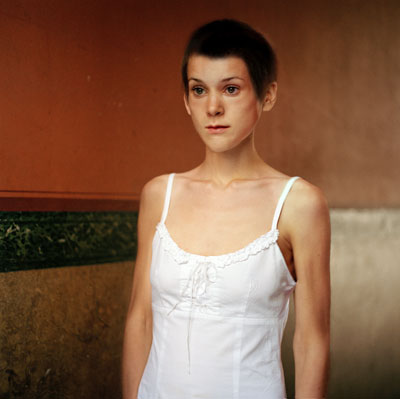 Eva Lauterlein, from Chimères The show's fascination with identity formation turns from global to personal in Swiss-German artist Eva Lauterlein's Chimères (Chimeras) series. Lauterlein creates idealized portraits by digitally collaging several photographs of her subjects into one super-image. The visual effect is subtle, but engrossing. Much like the uniform perspective in Gregory Crewdson's cinematic photography, there is a sense that something almost intangible just isn't right. Perfection, the eye discovers, is more unsettling than beautiful. The concept expands on traditional modes of portraiture, when painters were expected to idealize their subjects for vanity and posterity. However, Lauterlein's subjects are not aggrandized, but instead are digitally made more themselves. In an era overwhelmed with personality profiles and digital personae, Lauterlein's often slightly alien portraits offer a visual parallel to the effect of constantly constructing and reconstructing our selves. 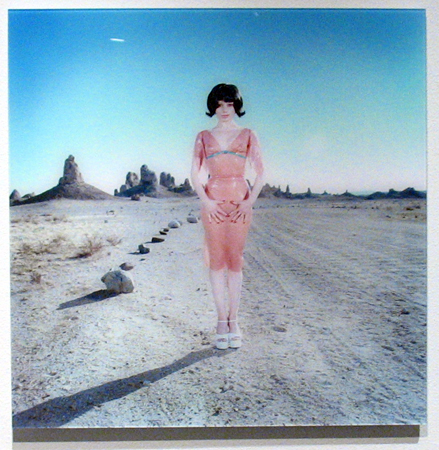 Marla Rutherford, "Abandoned Housewife" American artist Marla Rutherford is interested in how normalcy is measured in contemporary society. Rutherford brings individuals from lifestyle fetish culture into almost painfully quotidian scenes. The relationship between fetish and "normal" appears especially surreal in Abandoned Housewife, which depicts a woman standing on a deserted desert road. Dressed in skintight translucent vinyl, stripper shoes, and a 50s-style flip wig, she stands perfectly still, hands splayed on her thighs, waiting. The image recalls the games of power and control so often played between a dominant and submissive in the fetish scene. In the "normal" world, these power struggle take on a much more sinister tone, enacted against the housewife instead of with her pleasure and consent. However, Rutherford's photographs don't simply remind us of the parallels between mainstream society and fetish culture. They suggest the increasing normalcy of alternative modes of sexuality, and more broadly, the endless cycle of absorption as "subculture" becomes "pop culture" and something new arises to take the place of the avant-garde. 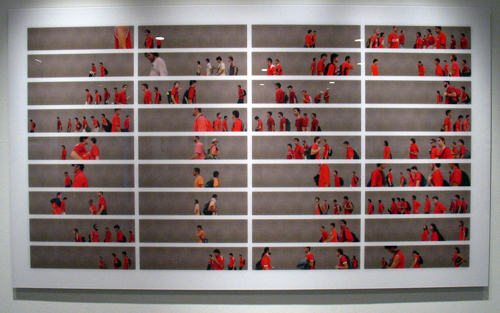 Pablo Zuleta Zahr, "Chilean Men in Red" Dominating the back wall of the exhibition is Chilean artist Pablo Zuleta Zahr's Chilean Men in Red. The size of the piece and the way that it melts from object to pattern recalls Andreas Gursky, only more human and intimate. Zahr builds these photographs by filming a single spot in a city for up to 10 hours. He then edits the footage to create a single image from a series of gridded stills, using the color patterns to construct an artificial relationship between strangers. This yearning for contact in the midst of an anonymous crowd is a timeless urban lament, revisited with a sharply modern aesthetic. 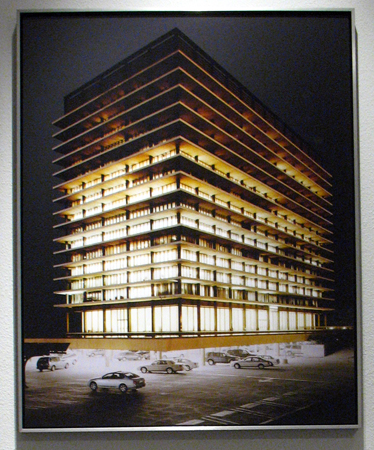 Mauren Brodbeck, "Untitled Urbanscape 6" Swiss-born Mauren Brodbeck is preoccupied with our relationship to space in an urban environment. Brodbeck's vision of a 21st century city is both intensely unnatural and extremely beautiful. She photographs urban spaces that we inhabit without thought, encouraging the city dweller to pay attention to the shapes, angles, and colors that constantly surround us. This interest in the patterns and functions of the manufactured landscape can also be found in the photographs of Rémy Lidereau, Josef Schulz, Natalie Czech, Leo Fabrizio, Miklos Gaál, Gábor Arion Kudász, Mona Schweizer, and Pétur Thomsen. Each artist takes a different approach, from a purely formal fascination with modern buildings to worrying over the effects of development on the Icelandic landscape, but the theme persists. reGeneration offers a sweeping, multi-ethnic view on the placement of our bodies and our land in a highly urbanized world. 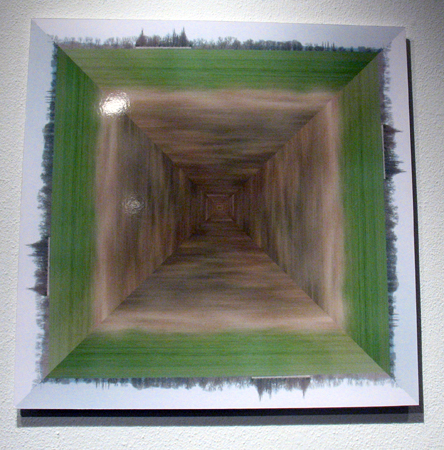 Kateřina Držková, from the Landscape series Although the classic modes of portrait and landscape are heavily represented (and re-imagined) in the show, photography's relationship with materiality is, with few exceptions, maddeningly ignored. Both the captions and the catalog entirely leave out notations on process, material, or even size. However, an exhibition on photography in our era would not be complete without work that interrogates the medium itself, and there are a few stand out pieces in the show that address the subject. Czech artist Kateřina Držková creates highly painterly images that, in turn, adopt painting's examination of flatness. Cropping and digitally transforming landscapes, Držková generates photographs that become almost abstract in their refusal of three-dimensional illusion. By insisting on flatness, Držková presents photographs as created images, not a passive expression of the artist's perspective, but an active expression of her vision. 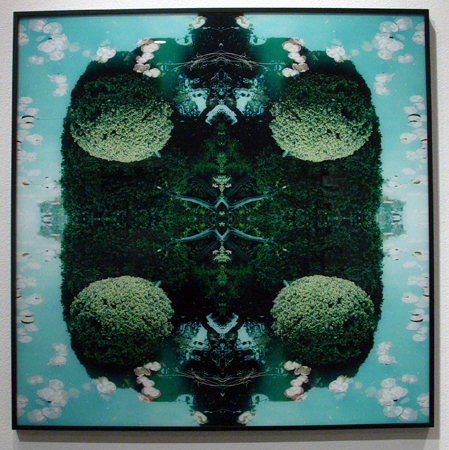 Ryo Ohwada, from the World of Round series In his World of Round series, Japanese photographer Ryo Ohwada plays a similar game with the effects of digital collage. Although he is less interested in the flatness of the photograph, his work evinces the same painterly aesthetic. Constructed through digital collage, both Držková and Ohwada offer a distinctly 21st century view on the boundaries of photography. In their work, the role of technology is not restricted to correction or illusion, nor does it overwhelm the original to become a purely digital or graphic art. Computers have visibly transformed the images, but they persist in their final form as photographs. 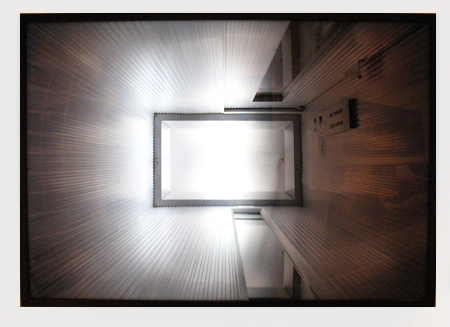 Marcello Mariana, "Via Arco 4" Italian artist Marcello Mariana plays the most flamboyant and visually appealing games with materiality. In his ottovariazionisulcielo series, Mariana photographs the interiors of elevators from the perspective of a person riding inside, looking up. What distinguishes his work from the other urban spaces is that it's mounted on a lightbox. The protruding box and glowing light offer a much more effective reconstruction of the experience of being inside an elevator than the photograph alone. (Although we can only dream of seeing such beauty in the drab, unedited interiors of your average elevator.) The lightbox also offers an alternative to the flat wall adornment that is every other photograph in the exhibition. The effect makes Mariana's work stand out dramatically, and makes me wish for more representation of creative approaches to printing and installation. 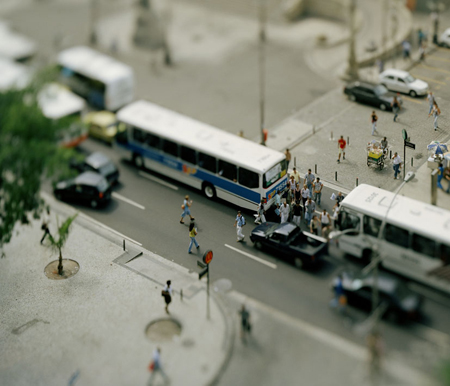 Miklos Gaál, "Avendia Presidente António Carlos" Through the themes of globalization, identity, warfare, modern spaces, and modern art making, the photographers of reGeneration have caught a complex but fairly accurate snapshot of the early 21st century. Although the chaos of the dense exhibition can make it difficult to view, it stays true to the sensation of being barraged by imagery to which we have grown accustomed. The works in the show are, finally, too many for this critic to recount. Go see them, and in twenty years, remember these names. reGeneration is on view at Lewis & Clark's Hoffman Gallery through March 15, 2009. Posted by Megan Driscoll on March 05, 2009 at 21:15 | Comments (0) Comments Post a comment Thanks for signing in, . Now you can comment. (sign out)
(If you haven't left a comment here before, you may need to be approved by
the site owner before your comment will appear. Until then, it won't appear
on the entry. Thanks for waiting.)
|
| s p o n s o r s |
 |
 |
 |
 |
 |
 |
 |
 |
 |
 |
 |
 |
 |
 |
 |
 |

|
Site Design: Jennifer Armbrust | • | Site Development: Philippe Blanc & Katherine Bovee | |

